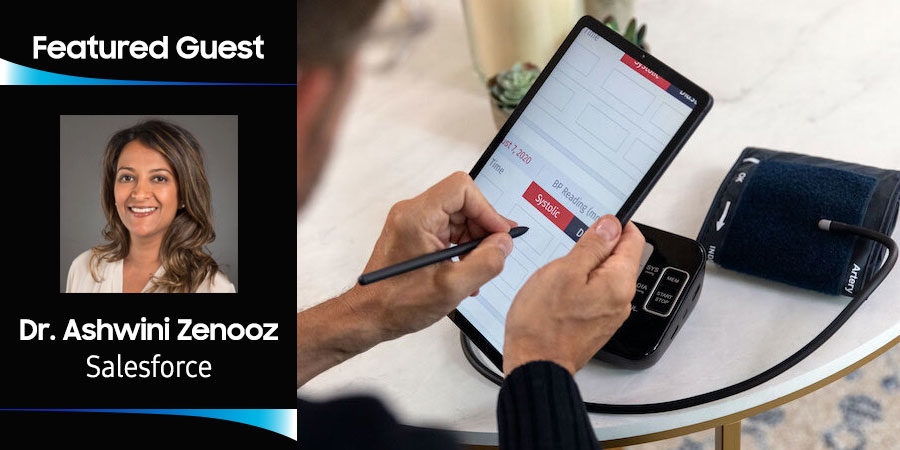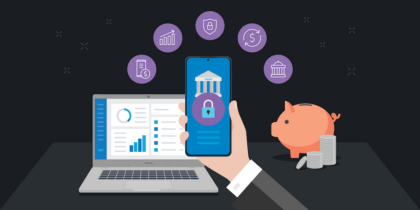Editor’s Note: This conversation is part of our ongoing “Future State Of” series. It has been edited for length and clarity.
Since the onset of the pandemic, access to virtual care and digital health services has rapidly expanded to address a surging demand of COVID-19 inquiries and cases, while also ensuring nonemergent patients could still receive care they need. The digital front door has been an essential tool in expanding access to these services. And while we’ve seen this acceleration around digital health and virtual care due to COVID-19, the underlying tech infrastructure is essential for solving for some of the challenges that have plagued healthcare for far longer, such as providing a truly consumer-centric experience and improving access and health across populations. Taher Behbehani, GM and SVP of Samsung B2B, sits down with Salesforce Chief Medical Officer Dr. Ashwini Zenooz to discuss how the pandemic is accelerating both the use of and the value of virtual care and digital health, and what role the digital front door plays in keeping individuals and populations well.
Taher Behbehani: Hi Dr. Zenooz, and thanks for speaking with me today. When it comes to healthcare, Salesforce may not be the first company that comes to mind. How long has Salesforce been in the space?
Dr. Ashwini Zenooz: Great to speak with you, Taher, and thank you for having me. Salesforce actually has a deep history of serving leading healthcare and life sciences organizations for over 20 years, and we’ve invested in foundational platforms that span the industry from providers and payers to pharmaceutical and medical device organizations. We offer solutions that enable customers to deliver care and experiences that are tailored directly to their patients and consumers, giving them the ability to collaborate and run their organizations as efficiently as possible. When compared with other industries, healthcare has been behind the times in terms of sparking a digital revolution, and Salesforce is helping to accelerate this shift by bringing a consumer-centric and tech-enabled experience to healthcare and life sciences.
TB: What kind of technology gaps in healthcare did the pandemic reveal, and what is being done to address those issues? What needs to change most about the current experience?
AZ: It has been interesting to see this pandemic expose the deep cracks in our industry that stem from years of mounting challenges across the healthcare delivery system. As soon as the pandemic started spreading in the U.S., we were hit with challenges of quality, cost and access that the industry has always faced, but all of a sudden we had to combat these obstacles on a massive scale that was difficult to support.
We need to empower consumers to participate in their own health and provide them the same omnichannel experience that they would expect from retailers. When I want to make a dinner reservation, for example, I can use any number of apps to look for nearby restaurants, check their menus, consider their prices, and select exactly when and where I want to dine. Where is that option in healthcare when we have a question about where to find the most up-to-date COVID-19 guidance, or when to seek out virtual care instead of risking entering a clinical setting, or even a simple breakdown of how much a COVID-19 test costs? If there is one silver lining of this pandemic, it’s that we finally have the impetus to start reimagining our healthcare system as a patient-centric and digital-first experience.
TB: At Samsung, the pandemic has inspired us to focus on ways to optimize the digital work-from-home experience. What has surprised you about the ways the crisis has accelerated healthcare’s embrace of digital solutions?
AZ: The accelerated use of virtual care has been both a blessing and a drastic change to many in the industry. I know this seems like a logical shift — and you’re probably thinking, “if we can pivot all our work meetings to virtual meetings, why should virtual care visits be any different?” — but this is a shift that has had a limited sense of urgency for so long. Now, with this pandemic, we’ve had to roll up our sleeves and figure out how all these institutions and end users can adopt new virtual technologies quickly and seamlessly. I saw a study that nearly 65 percent of doctors now feel fully prepared to use telehealth once this pandemic is over, which is a huge step for the industry in establishing a digital front door for healthcare.
TB: As hospitals begin to get back to performing elective procedures, how do you see technology playing a role in what I assume will be an incredible run on these services?
AZ: Technology is, and will continue to be, crucial in helping providers reconnect with patients to ramp up their full health services again, especially with the elective procedures that COVID-19 delayed. Digital engagement through intelligent technology will be able to optimize much of the administrative leg work involved, such as patient outreach, information dissemination, and equipment or PPE allocations. With automated and targeted outreach, we can reach patients at the right time by their preferred method to make sure they are rescheduling their appointments, remembering to come in for their procedures, and even following up with post-op care and regimens.
Beyond offloading outreach work, providers and clinical leadership will be able to use data and analytics platforms to prioritize their backlog of patients based on need and urgency, as well as manage a whole slew of operational factors such as block utilization, supplies, staffing, beds, facilities and so on. Wherever there’s a shortage or a prioritization need, big data solutions will be able to help allocate resources as effectively as possible.
There’s so much administrivia in healthcare that is only exacerbated by this backlog of elective procedures right now. If we can use technology to take on this work at scale, we can allow our clinical frontlines to focus on what they do best: delivering high quality care to those who need it most.
TB: At Samsung, we are constantly trying to find technology solutions to address the problems of the modern workforce, including a focus on digital security as more people address sensitive matters while working from home. How is Salesforce addressing increasing security issues, which are always an important topic in the healthcare space?
AZ: Well, first and foremost, trust is our number one value at Salesforce above all else; it always has been. And trust is never more important than in highly regulated industries like healthcare, life sciences and public health. That’s why we partner with customers to meet government compliance and security standards such as HIPAA, HITRUST, Part 11, FedRAMP and more. We share the responsibility in protecting patient data by securing customer data on our platform, and by inviting customer developers and admins to configure the platform to meet their company’s and customers’ needs.
We also have a Chief Ethics Officer who is focused on creating an ethical internal culture and product design process. We have a strategic framework for the ethical and humane use of technology across our organization, which we unwaveringly adhere to in every aspect of our business.
TB: I imagine that digital health is increasing access to significant new data streams. What will healthcare look like when we unlock the full potential of our data asset?
AZ: I’m glad you asked. Our industry has so much data at our fingertips, and it’s really exhilarating to know that we’re on the precipice of being able to unlock it. Healthcare generates almost one-third of the world’s data. Incredible, right? Unfortunately the great majority of this data is just sitting in silos and is stored among incompatible systems. But, you’re right, we are finally starting to see the sharing of data back and forth and we’re logging our data sets into data visualization tools to generate insights. If we, as an industry, can harness our data asset, normalize it into structured formats and put it into action using artificial intelligence, we can move from reactively delivering care, to proactively enabling health.
TB: Many people have written about the fact that access to virtual care and services are not evenly distributed across all populations because of access to broadband and devices and other issues. What can be done to make sure that all people have equal access to this incredible new way to stay well?
AZ: You’re absolutely right that there is a disparity — and not just in healthcare — between the digital “haves” and “have-nots” in this country. In healthcare specifically, it is imperative that we lessen this divide as we increasingly move to more virtual care options in this new normal. The good news is, close to 100 percent of Americans have some form of internet access, whether it’s through a personal router, a public library, mobile access or other available hotspot, and over 90 percent Americans actively choose to use their internet access. So, as long as our patient populations simply have access to email or other basic forms of digital communication tools, we will always be able to find ways to thoughtfully engage with them. Not all engagement needs to come in the form of a virtual care visit; in fact, most of it shouldn’t. We can still send reminders for patients to stay on top of their care regimens, fill their prescriptions, get their steps in and schedule care appointments when needed.
TB: Dr. Zenooz, thanks so much for your time. Is there any aspect of healthcare’s digital transformation that we have not touched on that you see as important?
AZ: It’s been a pleasure talking with you, Taher. I’ll leave you with one parting thought. It’s clear that the entire industry needs to start adopting and developing more innovative technologies as we come out of this pandemic, but there’s another core competency that we absolutely cannot overlook: social determinants of health. COVID-19 has shed a light on how certain populations are disproportionately affected by health crises, and we need to make sure we actively consider social determinants of health when making care decisions. This is where the future of healthcare is headed. If we’re moving towards a truly patient-centric industry, we need to consider all patients of all backgrounds, financial means and geographic locations. I’m so excited about the future of this industry coming out of this pandemic, because we have the incredible opportunity to reshape healthcare as a people-centric, digital-powered and equal-access system for all.
Discover how Samsung’s digital health solutions are paving the way for the new era of care. And keep up to date with the latest announcements and insights by following Taher Behbehani on Twitter.








